 Hartlepool Sports & Leisure
Hartlepool Sports & Leisure
- Cinemas, Theatres & Dance Halls
- Musicians & Bands
- At the Seaside
- Parks & Gardens
- Caravans & Camping
- Sport
 Hartlepool Transport
Hartlepool Transport
- Airfields & Aircraft
- Railways
- Buses & Commercial Vehicles
- Cars & Motorbikes
- The Ferry
- Horse drawn vehicles
 A Potted History Of Hartlepool
A Potted History Of Hartlepool
- Unidentified images
- Sources of information
- Archaeology & Ancient History
- Local Government
- Printed Notices & Papers
- Aerial Photographs
- Events, Visitors & VIPs
 Hartlepool Trade & Industry
Hartlepool Trade & Industry
- Trade Fairs
- Local businesses
- Iron & Steel
- Shops & Shopping
- Fishing industry
- Farming & Rural Landscape
- Pubs, Clubs & Hotels
 Hartlepool Health & Education
Hartlepool Health & Education
- Schools & Colleges
- Hospitals & Workhouses
- Public Health & Utilities
- Ambulance Service
- Police Services
- Fire Services
 Hartlepool People
Hartlepool People
 Hartlepool Places
Hartlepool Places
 Hartlepool at War
Hartlepool at War
 Hartlepool Ships & Shipping
Hartlepool Ships & Shipping

Seaton Hotel
Details about Seaton Hotel
From 1787 the Ship Inn was being advertised to be let with two fields adjioning and several houses and garths. The occupants of the houses were Richard Walker, Joseph Dobson senior, Elizabeth Bell, Ann Liddell, James Lithgo and Robert Ferguson.
Newcastle Courant 19th February 1791:
'To be let (for a term of years if required) and entered upon the 12th of May next, the Ship Inn at Seaton Carew near Hartlepool, with the gardens, stables, coach houses and other offices and conveniences, and a sufficient quantity of ground thereunto adjoining. Seaton is well known to be the most pleasant and elible situation on the coast for sea-bathing. The town is close upon the beach which is remakably fine smooth and firm for several miles on each side and furnishes one of the most pleasing rides in the country, commanding not only a beautiful sea prospect, but a delightful view of the Tees Bay, Cleveland Coast, hills &c on the opposite shore. This Inn has been for many years much frequented and well accustomed, particularly in the Bathing Season; and to render it more commodious and to encourage a good Tenant, the Proprietor is willing to make such additions and improvements as may be deemed useful and necessary. Mr George Metcalf of Seaton will show the Premises; and Mr Mowbray of Sherburn House, near Durham will let the same.'
It appears that the property did not attract a tenant as George Pearson, a wealthy gentleman of Durham who already had considerably property in Seaton Carew, by 1792 had purchased the Ship Inn & all that went with it. By 1794 he had pulled down the old building & had a coach house & three adjoining houses built on the site to cater for the wealthy Quakers who frequented the village during the summer months. The coach house was named the New Inn & remained so until the name changed to the Seaton Hotel between 1800 & 1804 although, on occasion, up until 1808 the media still referred to the property as the Ship Inn. The lodging houses in Church Street were connected by a passageway through the cellars from the inn kitchen.
Location
Related items :
 Aerial shot of Seaton Carew Front
Aerial shot of Seaton Carew Front
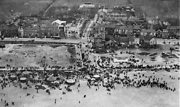 Donated by Hartlepool Library Service
Donated by Hartlepool Library ServiceAn aerial shot of Seaton Carew Front at the junction with Church Street. The Seaton Hotel is the white building in the picture. A busy day with lots of people about and shows on the beach. No bus station which was built in the 1930s.
HHT&N 570
More detail » Seaton Hotel
Seaton Hotel
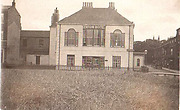 Donated by Maureen Anderson
Donated by Maureen AndersonPart of the Hartlepool Public Houses collection
An early image of the hotel. It can clearly be seen by that a building has been removed between the hotel and the building opposite.The structures that can be seen to the rear of the hotel have also changed.
More detail » Seaton Hotel
Seaton Hotel
 Donated by Hartlepool Library Service
Donated by Hartlepool Library ServiceThe Seaton Hotel, Church Street, Seaton Carew. A view of the Hotel with the fence around the outside. The fence was removed in the 1990s.
More detail » Seaton Hotel
Seaton Hotel
 Donated by Hartlepool Museum Service
Donated by Hartlepool Museum ServiceEarly picture of the Seaton Hotel when the proprieter was G Hodgson (c1902). I have never seen a picture with a Garage sign above the bay window. There is also adverts for food on the front to the building.
More detail » Seaton Hotel - over a century of landlords
Seaton Hotel - over a century of landlords
The first landlord was James Yarrow & 1793 he was advertising the Inn to be let from May Day 1794.
Newcastle Courant Saturday - 12 October 1793:
'The Capital new built Inn at Seaton Carew in the County of Durham, now occupied by Mr James Yarrow with a variety of convenient Offices and Buildings, and a Bowling Green, Garden, and several Clofes of rich Meadow & Pasture Ground, and a number of Stints or Cattle Gates in Seaton Marsh thereunto belonging-and alfo three new-built Dwelling Houfes adjoining to and communicating with the Inn intended for Lodging Houfes. The houfes are moft delightfully and commodioufly fituated for Sea-bathing, have been confantly filled with genteel company the laft Summer, and will no doubt continue to be fo in the future if the conduct of the Innkeeper merit the efteem of the Public. At Seaton there are an excellent Tepid or Hot Bath, and feveral Sea-bathing machines; and alfo two promenades or covered walks, each above 60 yards in length; befides flagged walks of much greater extent. The coaft or beach for near six miles in length is one of the firmeft and beft in the North of England.'
Alexander Goalbraith & his wife Elizabeth took over the Inn & appeared to have run it with great success.
Newcastle Courant Saturday - 28 May 1796:
‘SEA BATHING. SEATON CAREW. Alexander Goalbraith returns his most grateful Thanks to his Friends for paft Favors, and takes the Liberty of aquainting them and the Public in general, that he fully continues the new inn at Seaton Carew; has taken the feveral elegant Lodging-Houfes adjoining the fame, and fitted them in the most genteel and comfortable Manner, fo as to be admirably well-suited for the Accommodation of private Families or fingle perfons; has has laid in a stock of neat Wines and other Liquors, of the beft Qualities. This Inn contains a very large and handfome Dining Room; a well-proportioned and very elegant Long-Room, 15 Feet High; Sitting-Rooms; commodious Bed-chambers; and a modern built Hot-Bath, with a convenient Dressing-Room adjoining. There are alfo Promenades and other pleasant Walks, which, as well as the Inn and other Houfes, have a much fuller command than any other Part of the coast of thofe delightful Land and Sea Profpects, for which the Neighbourhood of Hartlepool ever been fo much and jufly admired. The Beach at Seaton is five Miles Iengtb, and of great Breadth at low Water, perfecly firm and fmooth; in fhort there is not perhaps in this Ifland, at leaft in the North, a Place fo well calculated for enjoying all the Comforts and Delights refulting from Sea Bathing, as Seaton Carew: the bathing Machines arc removed, with the otmoft Facility, to any Depth that may be required. There is regular Poft eftablifed from Stockton, and Carrier every Day in the Seafon.— Mr Goalbraith has engaged proper Cooks, Waiters, &c. and flatters himfelf, that by his earneft and unremitting Endeavours, to give Satisfacion (his Board and Lodgings being on the moft reafonable Terms) he fhall merit the Approbation of thofe who may be pleafed to honour him with their Company. N. B. Assemblies twice a Week as ufual.’
York Herald Saturday - 25 May 1805:
‘SEA BATHING—ALEXANDER GOALBRAITH returns his grateful thanks to his Friends and the Pub lic in general for the favour of their company for many years past, and takes the liberty to solicit a continuance of that support, which it will be his earnest wish and endeavour to merit. He thinks it necessary to intimate, that many of his friends were prevented from taking the benefit of the early season last year, by a report improperly circulated that the Lodgings were all occupied. The Beach at Seaton is remarkably pleasant, on a fine hard sand, five miles in length. The distance from Stockton is within ten miles, from whence the post arrives every day during the season. Application by Letter, (post-paid) will be immediately attended to. Seaton' Hotel, May 10, 1805.’
Alexander died between 1806 and 1810 and his widow, Elizabeth, took over the running of the hotel until retiring in 1826.
Robert Proctor took over the hotel in 1827.
Durham Chronicle - Saturday 3 May 1828:
‘SEATON HOTEL. ROBERT PROCTER returns his sincere thanks to those Friends who have kindly supported him during the time he has occupied the above Inn, and respectfully begs to assure them and the Nobility, Gentry, and others who frequent the FASHIONABLE WATERING PLACE of Seaton Carew, that he is determined to everything in his power to please; and from the excellent quality of his Wines &c., and the superior accommodation the premises afford, he hopes to meet with a continuance of patronage.’
Thomas White took over the hotel in 1830.
York Herald – Saturday 1 May 1830:
‘SEATON HOTEL, MOUTH OF THE RIVER TEES. THOMAS WHITE, with the most profound respect, begs to inform the Nobility, Gentry, and others, Visiting Watering Places, that he has taken the above Hotel, and purposes entering upon it at May-Day next. He takes this opportunity of returning sincere thanks for past favours (when in a similar situation at Cotham), and most respectfully solicits a continuance of favours ; which, by a constant attention to please, and keeping every article necessary for such an Establishment, of the best quality, he trusts to merit support. April 26th 1830.’
Thomas White died in 1834 and the tenancy was taken over by William Watt.
Durham County Advertiser – Friday 9 May 1834:
‘SEATON HOTEL. WILLIAM WATT BEGS to inform his Friends and the Public, that he has entered upon the above Inn, which he has fit up so as to be very commodious and comfortable for genteel families. GOOD STABLING for THIRTY HORSES, with COACH-HOUSES, and every other Convenience. W. W. can accommodate his Friends with Warm, Shower, and Cold BATHS; he has also laid in a choice ASSORTMENT of WINES and SPIRITS the first quality. W. W. hopes to partake of a share of public patronage; and it will be his entire study to make his guests comfortable.’
In 1844 the hotel was mortgaged to several parties and in the same year Mr Allinson, a Darlington solicitor, who was responsible for the interests of the mortgagees, signed an agreement for the sale of the premises to Mr Ramsey for £2,000. The hotel was to be continued to be run by tenants.
George Emmerson and his wife took over the hotel in 1837 and shortly after new windows were put into the building to command better sea views. George died in late 1846 and the hotel was advertised in various newspapers to be auctioned on 30 April 1847.
‘SEATON HOTEL, NEA R STOCKTON- UPON- TEES. TO SOLD BY AUCTION, UPON THE PREMISES, On Friday, the 30th day April, 1847, at three o'clock in the afternoon
TIIE CELEBRATED SEATON HOTEL, with the DWELLING-HOUSE adjoining, situated at Seaton Carew, near the flourishing Towns and Ports of Stockton and Hartlepool, in the County Durham, either together or in lots, subject to conditions to be then produced. The Hotel comprises a capital and excellent DWELLING-HOUSE, containing 8 Sitting Rooms and 21 Lodging Rooms, with a convenient bar, Kitchens, Sculleries, Cellars, Stabling, Coach-Houses, GARTH, GARDENS, and every Convenience suitable for carrying on a Hotel of the highest respectability. The Dwelling-House adjoining contains many excellent Sitting Rooms and Lodging Rooms, with convenient Out-offices. This much-frequented and long-established inn has , for upwards of half a century, attracted the patronage of the leading Nobility and Gentry of the Counties Durham, York, and Northumberland, who have visited this celebrated resort for the purpose of Sea-bathing, and is now offered for Sale in consequence of the death of Mr. Emerson, the late owner and occupier. The Railway accommodation, the opening of the lines connected with the York and Newcastle Railway, has already considerably increased the influx of Visitors—which increase may reasonably expected to experience a much further augmentation when the projected line from Leeds to Hartlepool is completed, as the distance between the great metropolis of Yorkshire and Seaton Carew will then accomplished less than two hours. The Hotel situated on a Marine Terrace, compassing the finest Sea Views, and being situated between the Tees Bay and the Port Hartlepool, is rendered not only desirable but exceedingly interesting to Visitors; the Sands, which are much admired for their firmness, extend for many miles, thereby affording every possible advantage of delightful and salubrious exercise to those frequenting this justly celebrated Sea-bathing Town. The whole of the FURNITURE, WINES, SPIRITS, and STOCK-IN-TRADE, to be taken at a Valuation. Two-thirds of the Purchase Money may remain on security of the Property; and if not Sold, the HOTEL will be LET on the day of sale. Mrs. Emerson, now residing in the Hotel, will shew the Premises, and of whom further information may obtained ; also of Messrs. BOWMAN A WATSON, Auctioneers, Darlington ; and at the offices of Mr. ALLISON, Solicitor, Darlington. ‘
The hotel was taken over in May 1847 by William and Dorothy Bond.
Durham Chronicle – Friday 18 June 1847:
‘THE SEATON HOTEL, near STOCKTON UPON TEES. Mrs EMERSON most gratefully tenders her Thanks and sincere Acknowledgments to her kind and numerous Supporters, during the Ten Years she has conducted the above Hotel, and on her Retiring from the Business begs most respectfully to recommend Mr. WM. BOND, her Successor, who, from his great experience in the management of an extensive Establishment of this nature, she trusts, and has no doubt will merit a continuance of the Patronage and Approbation which, on her retirement, she has now again the honour of acknowledging. Seaton Carew, 26th May, 1847.
WILLIAM BOND most respectfully begs to announce to the Nobility, Clergy, and Gentry, Visitors of the above Hotel that he has taken and entered upon the same, lately conducted and carried by Mrs. Emerson, with so much satisfaction to her Friends and Supporters. The Hotel, as fitted up by Mr. Bond, is now replete with every Comfort and Convenience, and is ready for the reception of the numerous and Fashionable Visitors who have so long honoured the Establishment. From his long experience in this branch of business, Mr. B. hopes to give the most perfect satisfaction, having selected the choicest Wines of the best Vintages, and Spirits of the first Quality, and spared no expense in providing everything requisite for the comfort of his Guests and Visitors, he trusts by constant and unremitted attention to merit a continuance of the Patronage and Support of the Nobility, Clergy, and Gentry, who have hitherto been in the habit of frequenting the Establishment, and also of those who in future may be induced to visit this Fashionable and truly delightful Bathing Place.
N.B.— Spacious Lock-up Coach Houses, Saddle and Harness Room. GOOD STABLING, &c., &c. An excellent Billiard Table is being fitted up on the Premises.
Seaton Carew Hotel, 26th May, 1847.
And there is now on Sale, at Bond’s Hotel, Hartlepool, an IMPERIAL PETROSIAN 12 Ft. BILLIARD TABLE, made by Thurston, two years ago, with India Rubber Cushions, on Eight Massive Turned Legs, best Superfine Cloth and French polished, including Cues, 3 Maces, a Marking Board, a long Cue, a Three Quarter Cue, a half-butt, a rest, the Rules in Frame, a Spirit Level, and a Brush.’
The hotel and the adjoining dwelling house were advertised to be auctioned in August 1850 with William Bond still the tenant. By 1852 the hotel was in the hands of Benjamin Murray and his wife Mary. The hotel became known locally as ‘Murray’s’.
In September 1853 the hotel and dwelling house were again advertised to be auctioned. In February 1854 it was advertised by private contract as the present owner, Benjamin Murray, was taking over the Royal Hotel in West Hartlepool. The dwelling house at No. 1 Church Street was advertised to be sold separately.
By July 1855 the hotel was in the hands of William Ramsey and was advertised to be let to a suitable tenant. He was possibly the Mr Ramsey who had purchased the hotel in 1844.
John Bird became tenant in 1858 and lived in the hotel with his wife, Mary, and son, William.
Durham Chronicle – Friday 22 July 1859:
‘SEATON HOTEL. JOHN BIRD begs respectfully to inform his friends and the public that he has taken the above Hotel, and entered upon the same, and be assures them that no expense nor exertion shall be spared, and every attention paid that can render this well-known and commodious Hotel conducive to the comfort and convenience of his patrons, and entitle him to their support. Well-Aired Beds, Private Rooms for Families. GOOD STABLING AND LOCK-UP COACH HOUSES. An Omnibus to and from the Hotel every train. June 14th, 1859.’
In January 1864 the hotel was advertised to be either sold or let at auction. James Hudson took over the tenancy and was reprimanded for breach of his licence in April 1865. From 1866 until 1869 the landlady was Mrs Sotheran. On 31 December 1869 Joseph Barker Hodgson acquired the hotel with its paddock & garden. Hodgson died in 1870 & the hotel was bought by Henry 'Harry' Thornton. Harry died on 11 April 1874 at the hotel and the hotel was once again up for sale by auction with a reserve price of £2,100.
From 1875 to December 1876 the landlord was Mr George Moffitt
Shields Daily Gazette – Tuesday 25 April 1876:
‘At the West Hartlepool Police Court Mr Moffitt, landlord of the Seaton Hotel, Seaton Carew, was summoned for having supplied refreshments during prohibited hours on Sunday morning week to several members of the 4th Durham Artillery Volunteer Band.—For the defence it was contended that the Seaton men were not supplied with anything to drink, and that as during the march to Seaton and back West Hartlepool by the road the band would have to walk nearly seven miles, the defendant assumed that they were bona-fide travellers ; moreover, the house bad not been opened any other persons —The Bench fined the defendant 40s and costs but the licence, however, was not to be endorsed.’
Daily Gazette for Middlesbrough – Tuesday 4 September 1877:
‘SALES BY AUCTION. SEATON HOTEL, SEATON CAREW. TO BE SOLD BY AUCTION, by Mr SHADFORTH, Auctioneer, under a writ of Fi Fa, at the Seaton Hotel on FRIDAY, the 7th Sept. 1877, the whole of the HOUSEHOLD FURNITURE, Stock-in-Trade, Bar Fittings, Fixtures, and other Effects, at the above Hotel, comprising, in the
Wellington - 6 Hair-seated Chairs, 1 Easy Chair, Mahogany Hair-seated Sofa, Mahogany Table, Brussels Carpet and Hearth Rug, Oilcloth, 3 cases Stuffed Birds, Oil Paintings, Chimney Glass in Gilt Frame, 2 Seta Damask Hangings, Fender and Fire-irons, Ornaments, &c, &c.
No. 1 Sitting Room - 2 Mahogany Tables, Mahogany Sofa in Hair-seating, 6 Arm Chairs, Carpet and Hearth Rug, Pictures, Clock, Fender, and Fire- irons.
Snug - 3 Hair-seated Chairs, 2 Arm Chairs, Long Table, Longsettle, Show Cards, 3 Pictures, Mantel Glass, Hearth Rug, Window BUnds and Shades.
Back Snug - Long Table, 7 Poles for Banners, Oilcloth.
Billiard Room - 5 Hair -seated Chairs, Sugar Cutter, Clothes Horse, Sundries, Spittoons.
Smoke Room - 6 Smoking Chairs, Large Table, Spittoons, 2 Cases Stuffed Birds, 5 Pictures, 4 Blinds and Rollers, Oilcloth, Hall Mats, Mahogany Table, 2 Side Tables, Clock, pair Buffalo Horns, pair Stag's Horns, Scraper.
Large Room - Excellent Brussels carpet, 9 yards by 7 yards (nearly new), Mahogany Table. Fender, Fancy Seat, 3 Sets of Window Hangings, OU Painting in Gilt Frame, 6 Pot Spirit Jars, Large Glass Chandelier, Set of Croquet, 6 yards Carpet.
No. 1 Bedroom - Half -Tester Bedstead and Hangings, Straw Mattress, Feather Bed, Pillows and Bolster, Sheets, Quilts, Blankets, Round Ma hogany Table, Square Table, Carpet, Hearth Rug, Oilcloth, Chest of Drawers, 3 Cane Chairs, Toilet Glass, Window Curtain, Chamber Ware.
No. 2 Bedroom - Bedstead, Straw Mattress, Sheets, Rug, 2 Small Tables, Toilet Glass, Chair, Carpets &c.
No. 3 Bedroom - Mahogany Four-Pole Bedstead, Crimson Hangings, Straw Mattress, Wool Mattress, Feather Bed, Bedding, Painted Press, Mahogany Drawers, Wash Stand, Toilet Table, Toilet Glass, 24 yards Carpet.
No. 4 Bedroom - Tudor Bedstead and Hangings, Feather Bed and Bedding, Wash Stand and Dress ing Table, large Looking Glass, 2 Chairs, Towel Rail, Brass Fender, Carpet (new), Hearth Rug, Chamber Ware, Towels, Window Shades.
No. 5 Bedroom - Half -tester Bedstead, Wool Mattress, Feather Bed, Wash Stand and Dressing Table, Chest of Drawers, Chair, Chamber Ware, Window Shades, Carpets, &c.
Servants' Room - 2 Iron Bedsteads, 1 Wood Bedstead, Feather Bed, 3 Mattresses, Bedding, Chair.
Drawing Room - Walnut Cheffonier with Marble Slab, Carved Back and Panels ; Oval Mahogany Table, Mahogany Side Table, 6 Mahogany hair- seated Chairs, Easy Chair, Mahogany Couch, large Velvet Pile Table Cover, 2 Vases, Fender, 2 large Oil Paintings, gilt frames, Window Shades, Glass Chandelier, Brussels Carpet, 23 yards, Hearth Rug.
Washhouse - Wringing Machine, Wash and Poss Tubs, Water Tub, Pots, Pans, and a large Variety of other Useful Household Requisites; Crockery- ware, Coffee Mill & c.
Cellar - Quantity of Cordials, 7 Barrels Beer, Quantity of Cook's Tools, Taps, 5 doz. Claret, Bottled Beer and Stout, Bottles, Store Casks, &c.
Stairs and Landing - Stair Carpet and Rods, Landing Carpet, 12 Yards Oilcloth, 6 Mats, Mahogany Table, Chairs.
Stable, Yard, &c.— Gray Mare “Jenny" 15 1-2 hands, quiet in all Harness, in foal to “Nelson”; 2 Sets Silver-mounted Harness, Useful Cab complete, Four-wheeled Phaeton, Useful Omnibus, Garden Tools, quantity of Harness. Poultry consists of Hens, Chickens, Ducks, Turkey. Silver-mounted Riding Saddle, Bridle, Reins, Dog Kennel, Large Box, Form, Weighing Machine, Iron Brake, Splinter, Bar and Pole, 2 Stove Pig Troughs, Wood Trough.
Bar - 4 Chandeliers, 2 splendid Glass Chandeliers, Excellent Bar Counters, fitted with 6 Beer Pumps and Piping complete.
Sale to commence at one o'clock in the afternoon, and as the lots are very numerous, the Auctioneer solicits an early attendance.’
In May 1879 the hotel was advertised to be let. In August of that year Mrs Moffitt was selling her furniture etc. as she was leaving Seaton Carew.
The hotel was taken over in 1879 by Anne (Annie) Thornton (nee Jackson), the widow of Henry Emanuel Dale Thornton who had been landlord of the hotel until his death in April 1874. By August 1880 the hotel had been thoroughly re-modelled and re-decorated by Annie. She ran the hotel until her death on 3 November 1888. As well as the hotel Annie also ran two cabs. The hotel was taken over by their daughter Emily who ran it until at least 1900 before she moved to Westbourne Road.
The Thornton family are interred in Holy Trinity Churchyarrd, Seaton Carew.
George Hodgson had taken over as landlord by 1902.
The hotel was purchased by Nimmos in the late 1920s & Whitbreads took over in 1963.
More detail »
 Seaton Hotel 1902
Seaton Hotel 1902
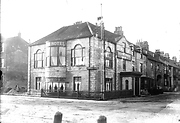 Donated by Hartlepool Museum Service
Donated by Hartlepool Museum ServicePart of the Hartlepool Public Houses collection
Seaton Hotel, Seaton Carew. When this image was taken in 1902 Mr Hodgson was the landlord.
HHT&N 600
More detail » Seaton Hotel 2012
Seaton Hotel 2012
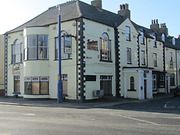 Created by Maureen Anderson
Donated by Maureen Anderson
Created by Maureen Anderson
Donated by Maureen AndersonPart of the Hartlepool Public Houses collection
Dated 2012
In November 2012 after having been closed for some time the hotel was sold by the brewery into private ownership.
More detail » Thornton - headstone [1]
Thornton - headstone [1]
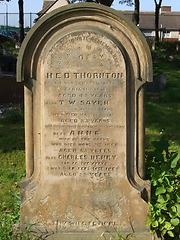 Created by Maureen Anderson
Donated by Maureen Anderson
Created by Maureen Anderson
Donated by Maureen AndersonDated 2007
The headstone in Holy Trinity Churchyard, Seaton Carew of Harry and Annie Thornton, proprietors of the Seaton Hotel.
More detail » Thornton - headstone [2]
Thornton - headstone [2]
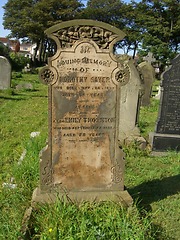 Created by Maureen Anderson
Donated by Maureen Anderson
Created by Maureen Anderson
Donated by Maureen AndersonDated 2007
The headstone in Holy Trinity Churchyard, Seaton Carew of Emily Thornton, proprietor of the Seaton Hotel.
More detail »




